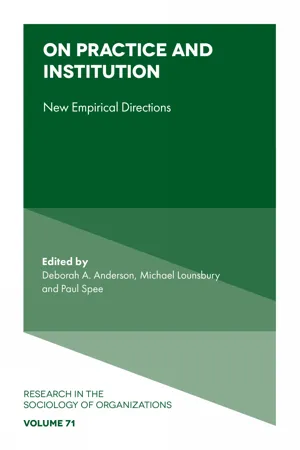2.1. Definitional Foundations
Over the last decades, organizational hybridity has received increasing scholarly attention using different theoretical lenses (Battilana et al., 2017; Battilana & Lee, 2014; Doherty et al., 2014). In their recent review of the growing body of literature on organizational hybridity, Battilana et al. (2017) identify three main approaches within this body of literature, emphasizing hybrid organizational identities, hybrid organizational forms, and the combination of different institutional logics, respectively. Based on their review of the literature, they offer a general definition of organizational hybridity as “the mixing of core organizational elements that would not conventionally go together” (Battilana et al., 2017, p. 129). To date, organizational hybridity has predominantly been studied in the context of social enterprises, that is, firms that pursue a dual mission of financial viability and social purpose and impact (Doherty et al., 2014; Litrico & Besharov, 2018). Accordingly, social enterprises have been characterized as the ideal type of hybrid organization (Battilana & Lee, 2014). At the same time, Battilana and Lee (2014) highlight that hybrid organizing is relevant beyond the realm of social enterprises. In this context, they suggest that hybrid organizing and the degree to which organizations combine opposing elements “follow a continuum rather than a dichotomy” (p. 425). In this chapter, I argue that business sustainability offers a suitable context to study different degrees of hybridity in organizations. While sustainability mandates firms to combine oftentimes competing social and ecological concerns with commercial considerations, firms adopt and integrate sustainability challenges to different degrees.
While ambiguity about the definition of the notion of business sustainability remains (Bansal & Song, 2017; Montiel & Delgado-Ceballos, 2014; Valente, 2012), most commonly business sustainability is conceptualized as the contribution of business organizations to achieving environmental integrity, economic prosperity, and social equity (Bansal, 2005; Montiel & Delgado-Ceballos, 2014; Scherer, Palazzo, & Seidl, 2013). Moreover, and in contrast to many more practitioner-oriented definitions, scholarly definitions of business sustainability tend to agree that business sustainability does not refer to the sustainability or longevity of an individual business (Bansal, 2002; Hahn & Figge, 2011). Rather, business sustainability is rooted in a systemic view (Bansal & Song, 2017) and highlights the embeddedness of business organizations in, and their dependence on, wider overarching economic, social, and natural systems (Valente, 2012). Therefore, while firms play a key role for achieving sustainability, because they represent the productive resources of the economy (Bansal, 2002), business sustainability is a society-level concept in the sense that “individual organizations cannot become sustainable: Individual organizations simply contribute to the large system in which sustainability may or may not be achieved” (Jennings & Zandbergen, 1995, p. 1023).
2.2. Sources of Hybridity in Business Sustainability
Based on this definitional core, it becomes evident that business sustainability is an innately hybrid concept in that it mandates firms to combine opposing elements that conventionally do not go together. More specifically, business sustainability brings together organizational level practices and system-level impacts, it encompasses a multiplicity of interrelated but oftentimes competing sustainability goals, and juxtaposes competing short-term and long-term time orientations. Attending to and mixing these opposing elements may translate into firms adopting hybrid organizational forms, identities, and logics in order to contribute to sustainability.
Traditionally, business firms focus on achieving organizational level outcomes such as profitability through the mobilization of organizational level resources and capabilities. By contrast, sustainability embeds business activities in a systems context and is concerned with system-level outcomes (Bansal & Song, 2017; Valente, 2012). From the perspective of sustainability “business firms are expected to improve the general welfare of society” (Schwartz & Carroll, 2008, p. 168) and organizational sustainability initiatives are motivated by targeting and addressing sustainability challenges at the systemic level in order to generate a positive impact (Dyllick & Muff, 2016). Business sustainability thus mandates firms to translate system-level challenges into organizational level initiatives and strategies. Accordingly, sustainability in new ventures has been theorized as hybridity in terms of the challenge to adhere to competing logics (De Clercq & Voronov, 2011). A systems logic reflecting the complex dynamics of social and ecological systems starkly contrasts with the dominant linear logic of traditional for-profit business organizations (Valente, 2010).
Another source of hybridity in business sustainability is the multiplicity of sustainability goals that businesses are confronted with. This multiplicity is best illustrated by the UN Sustainable Development Goals (SDGs) that are increasingly used as a reference for business contributions to sustainability (George, Howard-Grenville, Joshi, & Tihanyi, 2016). The SDGs comprise an agenda of 17 different goals that need to be achieved simultaneously for moving toward sustainability at the global level. However, while these goals all appear desirable in isolation, they are “inextricably connected and internally interdependent” (Bansal, 2002, p. 123). Their simultaneous pursuit entails the risk of unintended consequences as advances in one area may well have repercussions in others (Newton, 2002). From a business perspective, this multiplicity of sustainability concerns gives rise to tensions (Vildåsen, 2018) since they go counter business-as-usual practices and strategies, leading to a “clash between the dominant business model […] and a longer-term sustainability agenda” (Scheyvens, Banks, & Hughes, 2016, p. 378). Integrating and embedding sustainability goals into ...
